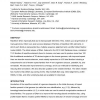Free Online Productivity Tools
i2Speak
i2Symbol
i2OCR
iTex2Img
iWeb2Print
iWeb2Shot
i2Type
iPdf2Split
iPdf2Merge
i2Bopomofo
i2Arabic
i2Style
i2Image
i2PDF
iLatex2Rtf
Sci2ools
NAR
2016
2016
The Dfam database of repetitive DNA families
Repetitive DNA, especially that due to transposable elements (TEs), makes up a large fraction of many genomes. Dfam is an open access database of families of repetitive DNA elements, in which each family is represented by a multiple sequence alignment and a profile hidden Markov model (HMM). The initial release of Dfam, featured in the 2013 NAR Database Issue, contained 1143 families of repetitive elements found in humans, and was used to produce more than 100 Mb of additional annotation of TE-derived regions in the human genome, with improved speed. Here we describe recent advances, most notably expansion to 4150 total families including a comprehensive set of known repeat families from 4 new organisms (mouse, zebrafish, fly, and nematode). We describe improvements to coverage, and to our methods for identifying and reducing false annotation. We also describe updates to the website interface. The Dfam website has moved to http://dfam.org (during review: http://v2draft.dfam.org). Seed...
NAR 2016 |
| Added | 08 Apr 2016 |
| Updated | 08 Apr 2016 |
| Type | Journal |
| Year | 2016 |
| Where | NAR |
| Authors | Robert Hubley, Robert D. Finn, Jody Clements, Sean R. Eddy, Thomas A. Jones, Weidong Bao, Arian F. A. Smit, Travis J. Wheeler |
Comments (0)

